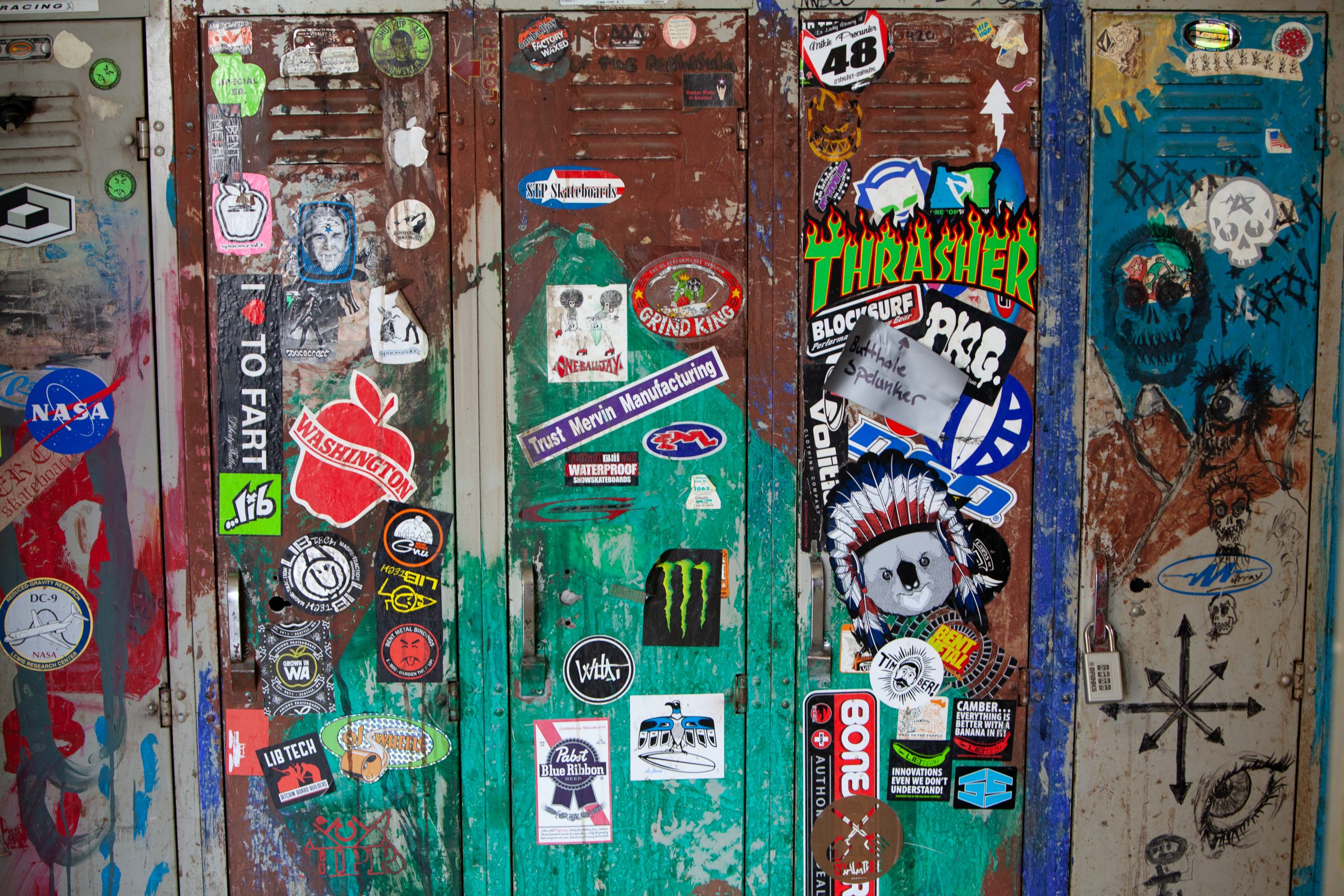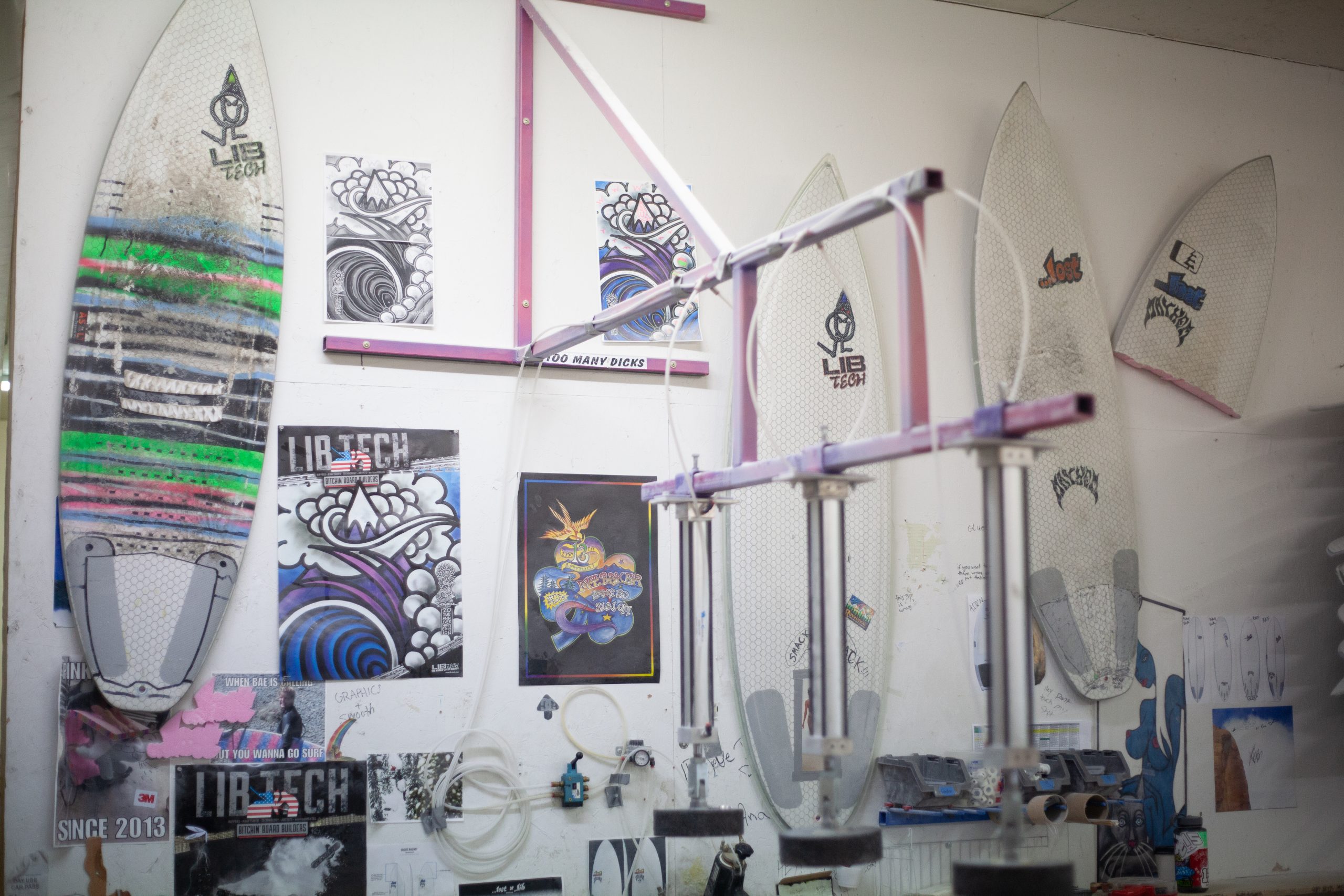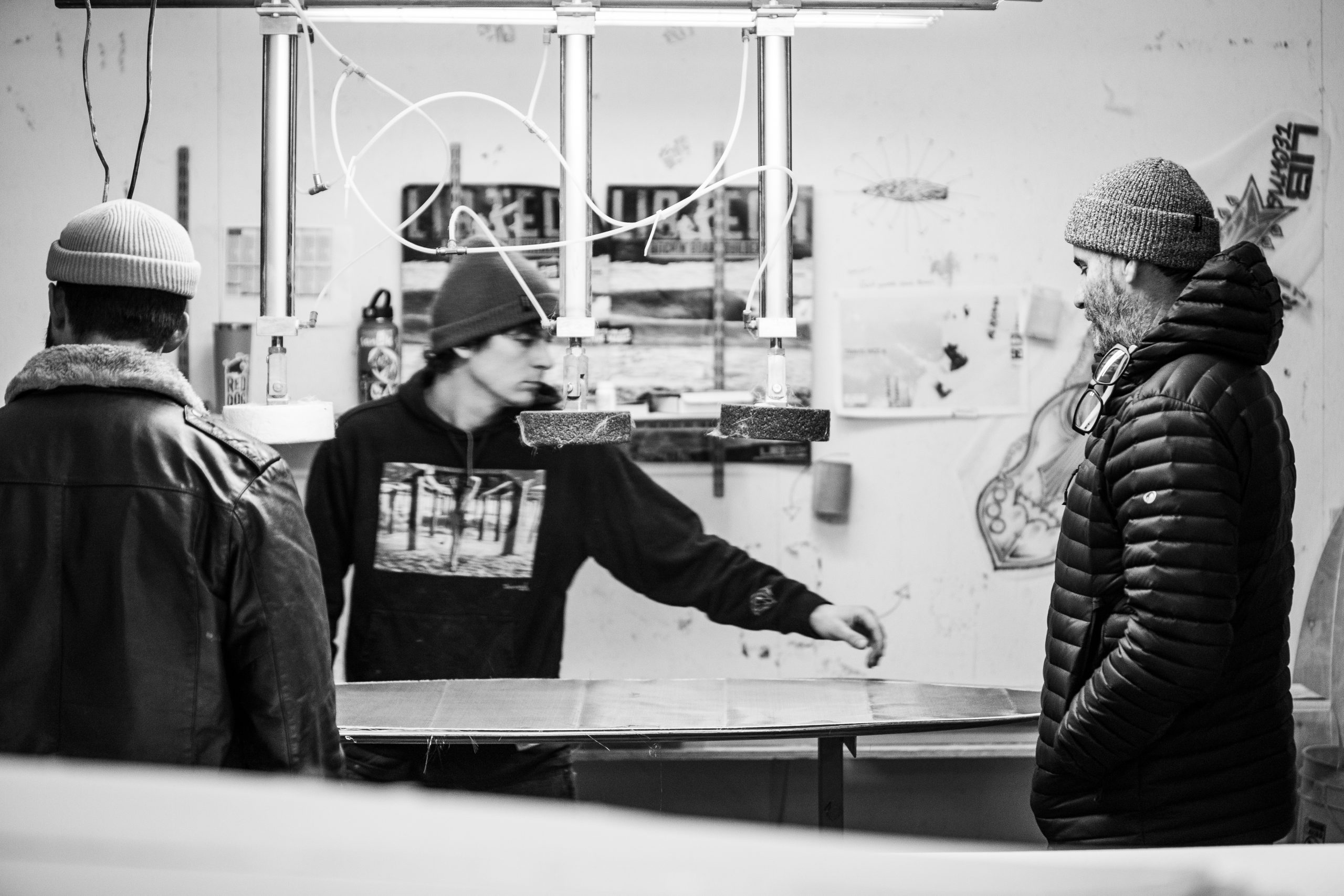How A Factory In Washington Is Building Viable Alternatives To All The Crappy Asian Imports
Matt Biolos, Lib Tech, and the case for the affordable, sustainable, American made performance surfboard.
“I’m not a tinkerer, but I love tinkerers,” Matt “Mayhem” Biolos tells me, as we make our way through the mountains outside Seattle, Washington, snow falling lightly and Olympic National forest deep green to the west, headed north.
In the last several years, lineups and surf shop racks alike have swelled with low-cost, overseas surfboards, largely sold on a consignment basis with generous repayment terms propped up by investors banking on surfing’s new populist wave delivering on their investment.
This is a problem.
And Mayhem is taking me to see a solution.
We are on our way to Carlsborg, Washington, to see Mervin Manufacturing, and the Lib Tech factory, where for the last decade Matt has worked with the “tinkerers” he’s referring to, Mike Olson and Pete Saari, developing new materials and processes manufacturing the most environmentally friendly, production-scale surfboards on the market.

Matt Biolos and Mike Olson, and just a few of the literally thousands of different snowboards, skis, skateboards, and surfboards Olson and the Mervin crew have come up with at their Washington factory.
Photography
Jared Smith
If the claims seem over-hyped, we’ll ask you do your research.
Born with a razor sharp if hyperactive mind that’s immediately apparent upon first encounter, Mike Olson has a seemingly preternatural gift for engineering and mathematics, and a Naturalist’s self reliance and appreciation for wild country and open land, ingrained by his father, an outdoorsman and ski instructor.
Building his first snowboard while in Junior High in 1978, Olson eventually dropped out of Pacific Lutheran University to build snowboards full-time in 1984.

Pete Saari and Mike Olson breaking down Lib Tech’s construction to Matt Biolos and Stab’s Editor, Ashton Goggans.
Photography
Jared Smith
“I worked out of an old rental race horse barn,” Mike tells me. “I financed the snowboard start-up by building surfboards and sailboards with a $49.00 black and Decker planer.”
In the last 35 years, Lib Tech has set a standard for domestic, sustainable manufacturing, the first in the industry to make it a focus, eliminating toxic ABS plastic and swapping recyclable materials all the way back in 1986, and in 1995 introducing the “first sustainable polymer topsheets and bamboo cores.”
But all along the way, while Mervin and Lib Tech were growing to be one of the largest snowboard manufacturers on the planet, the duo always kept a fire going on the side, working on bizarre and occasionally brilliant new shapes, non-standard space age foams and resins, asymmetrical outlines and fins, you name it.

With a wildly detailed process in place, Mervin’s crew build boards with less time and materials wasted than any factory in the world.
Photography
Jared Smith

Employee lockers at Mervin Manufacturing’s Washington compound, where a hive of snowboarders, skaters, and surfers put in honest 40-hour weeks fine tuning equipment.
Photography
Jared Smith
“I built a strange variety of surf shapes in the first half of the 1980’s,” Olson says “I built boards out of Paulownia skins, thermo elastomer skins, prepreg skins, PP skins, EVA skins, Aspen skins, EPS cores, XPS cores, EPP cores, soy based PU cores, sucrose based PU cores, honeycomb shaped foam, and even used skateboard style urethane as our resin, etc.”
See what I mean? Madness.
But out of all the resin, foam, and fiberglass Olson and Saari threw at the wall, a few of Mike’s mad mixtures yielded incredible results, which spurred interest from some of the most respected figures in surfboard design, and ultimately Matt Biolos, who they’d known as a lifelong snowboarder and fan of the brand.
“I honestly asked them to do a collab as soon as I saw the tech, almost ten years ago,” Mayhem says. “They’ve been leaders in tech and design of snowboarding forever, and I was confident surf could follow, for so many reasons. With strength-to-weight ratio, they match or are better than any Asian import composite. Made in USA is a big one. And the materials looked like nothing anyone else was using.”

“It sounds strange, but our whole construction uses proprietary materials or ones we introduced—other than the 10/24 stainless fin screws,” says Mike Olson.
Photography
Jared Smith

“A few years ago, it would not be possible to make these boards,” says Mike Olson.
Photography
Jared Smith.
“It sounds strange, but our whole construction uses proprietary materials or ones we introduced—other than the 10/24 stainless fin screws,” Olson admits. “All of our fibers and fabrics—magnesium fiber and fly-weight basalt—are custom made, and most have never been made to our configuration before.
“Our resin system is custom blended for us, and is very necessary for our process to be achievable. A few years ago, it would not be possible to make these boards.”
One of Mike’s “most radical and important discoveries” is Nitrogenecell foam, comprising cells that are pressurized by nitrogen and which have an elongated structure, with an orientation from top to the bottom on the blank, providing high compression strength on the top and bottom, and unparalleled resilience on the rails for durability as far as rail smashes go. Their foam blowing agents have a Zero Ozone depletion rating.

““The process we use incorporates much safer materials, minimizes sanding steps and exposure to resin for our crew. Our shop smells good. I love walking into our shop and not feeling dizzy or sick and knowing that our crew isn’t being exposed to hazardous materials.”
Photography
Jared Smith

Matt Biolos and Stab’s Ashton Goggans, looking over a Round Nose Fish Redux, fresh off the spotless Lib Tech production line.
Photography
Jared Smith.
By the time Olson had built a prototype he was happy with, they’d made more 3,400 blanks “just to run our formula through the machine,” Olson says. “It was a giant Hail Mary, but it worked out fantastic”
“The boards just looked intriguing, and I felt and feel that there’s a place in the market for an American-made board, that’s built to last, using tricky, ecologically conscious manufacturing process—and not just marketing bullshit—at an affordable price, with proven shapes and designs that surfers are confident in, Matt says. “And that’s where …Lost fit in.”
“We have always admired Matt’s surf business—watched all his movies and enjoyed the mix of chaos and board performance,” Saari says of their initial attraction to working with Mayhem. “We felt a lot like we were very similar companies working hard, playing hard and having fun. I think his crew played a little harder than we did [laughs]
“When it came time to work with a shaper, we felt like he was the best guy in the world. He is a very technical designer. He shapes for the world’s best surfers, but also has a very good understanding of the Average Guy buying boards, and how to take what he learns from the pros and apply it to improve performance on an Everyman’s board. It has been really fun to get his perspective.”

Matt Biolos and Ashton Goggans admiring one of Lib Tech’s many work stations, custom designed to each step in the construction process.
Photography
Jared White.
Of all the major snowboard brands that saw rapid growth throughout the 90s and ‘00s, Lib Tech are the only still manufacturing state of the art equipment in the United States. Their factory is a bustling hive of careful processes being executed skillfully by well-trained, well-paid Americans, almost all of them skateboarders, surfers, and snowboarders, thrilled with the quality of life and access the area and opportunity provides. Like Yvonne Chouinard and others before them, Mike and Pete are widely beloved within the snowboard industry, considered humble visionaries, etc.
“The process we use incorporates much safer materials, minimizes sanding steps and exposure to resin for our crew,” Saari says, proudly. “Our shop smells good. I love walking into our shop and not feeling dizzy or sick and knowing that our crew isn’t being exposed to hazardous materials.”

When it comes to what employers like to refer to as “Quality of Life,” surfers, skateboarders, and snowboarders might be hard pressed to find a location as ideal as Mervin’s scenic Washington outpost.
Photography
Jared Smith.
Their Carlsborg compound—complete with snake-run walking paths between buildings and located at the base of snowcapped mountains and a short drive from a handful of occasionally world-class waves along the Straights of Juan de Fuca—creates zero hazardous waste, the air inside each of the factory building’s almost fumeless, and perhaps most impressive for anyone who has tried to scrub foam or fiberglass dust out of their pores, the process creates a truly tiny fraction of the dust and waste.
As someone who is more than familiar with the standard pitfalls of traditional surfboard construction, Mayhem sees the innovations in materials and the remarkable efficiency with which they’re made as an extraordinary accomplishment, and one every surfer should consider when choosing their equipment.
“Just the way they lay everything up and the lack of intense labor needed—No dust. No sandpaper! No paint! No nuthin!—it’s fucking crazy,” Mayhem says. “The marketing and overhyped bullshit from many brands these days calling their boards “Sustainable” and “Eco-Friendly” is a total joke. Trust me, I know. I build boards in every continent on earth. There’s nothing sustainable about oil tankers shipping boards around the world.”

“When it came time to work with a shaper, we felt like Mayhem was the best guy in the world,” says Pete Saari.
Photography
Tim Zimmerman.
Currently, Lib Tech offers a handful of Mayhem’s trusted models—the Quiver Killer, Sub Buggy, Puddle Fish, Short Round, Puddle Jumper, as well as the most recent take on the iconic 5’5″ 19 1/4 fish, the RNF Redux—all utilizing their proprietary tech, which they continue to develop and improve upon.
You can learn more about Mervin Manufacturing, here, and purchase Mayhem and Lib Tech’s bulletproof American sleds, here.
*This story originally appeared under the title “There’s nothing sustainable about oil tankers shipping boards around the world.”





Comments
Comments are a Stab Premium feature. Gotta join to talk shop.
Already a member? Sign In
Want to join? Sign Up